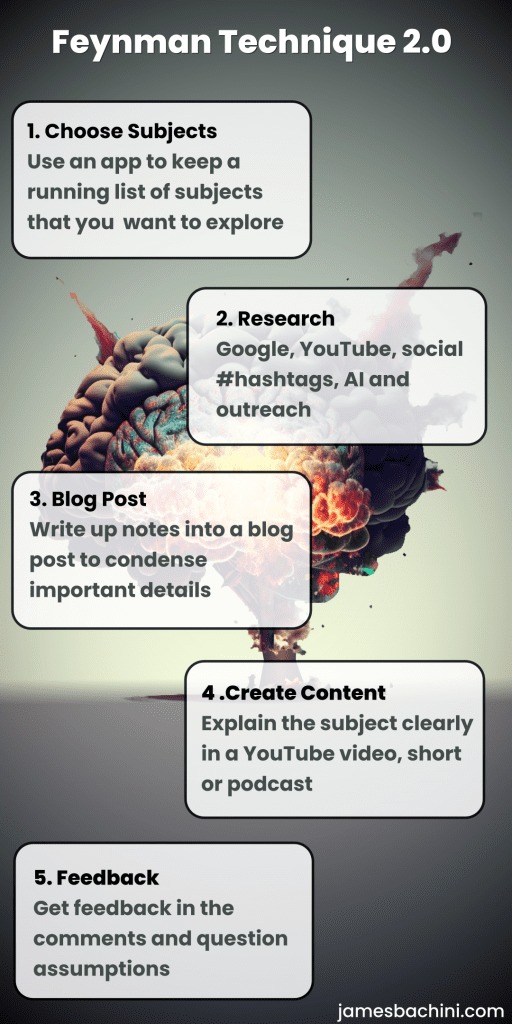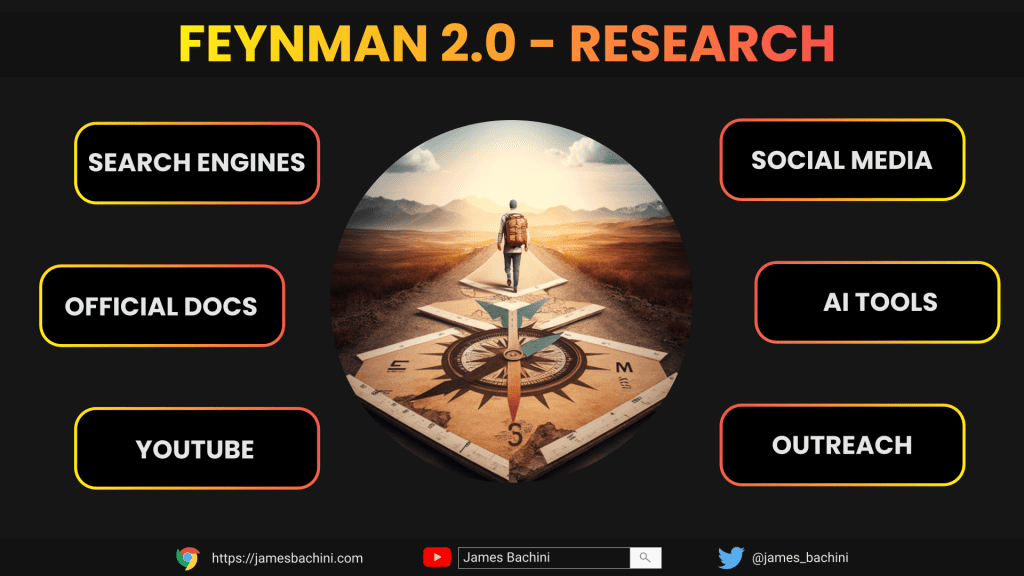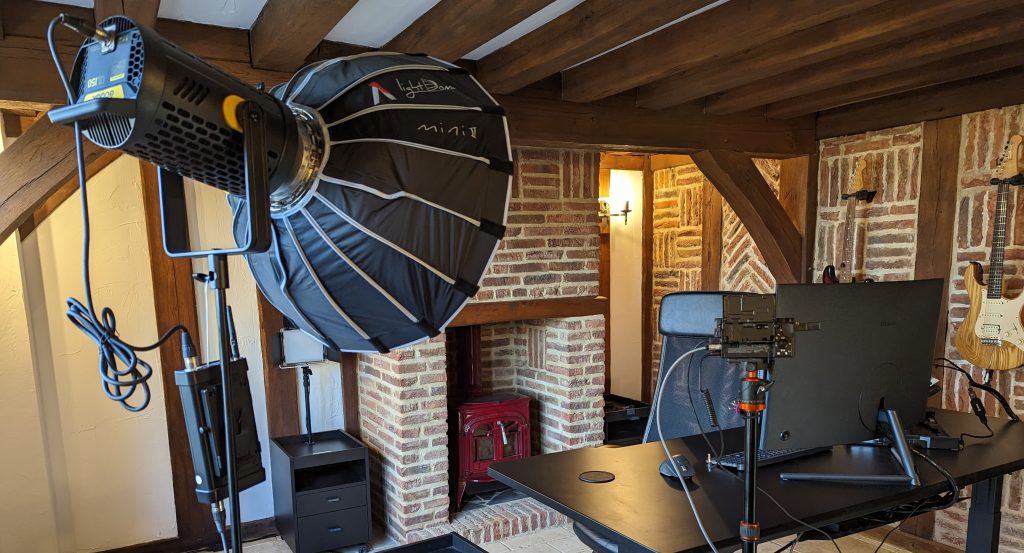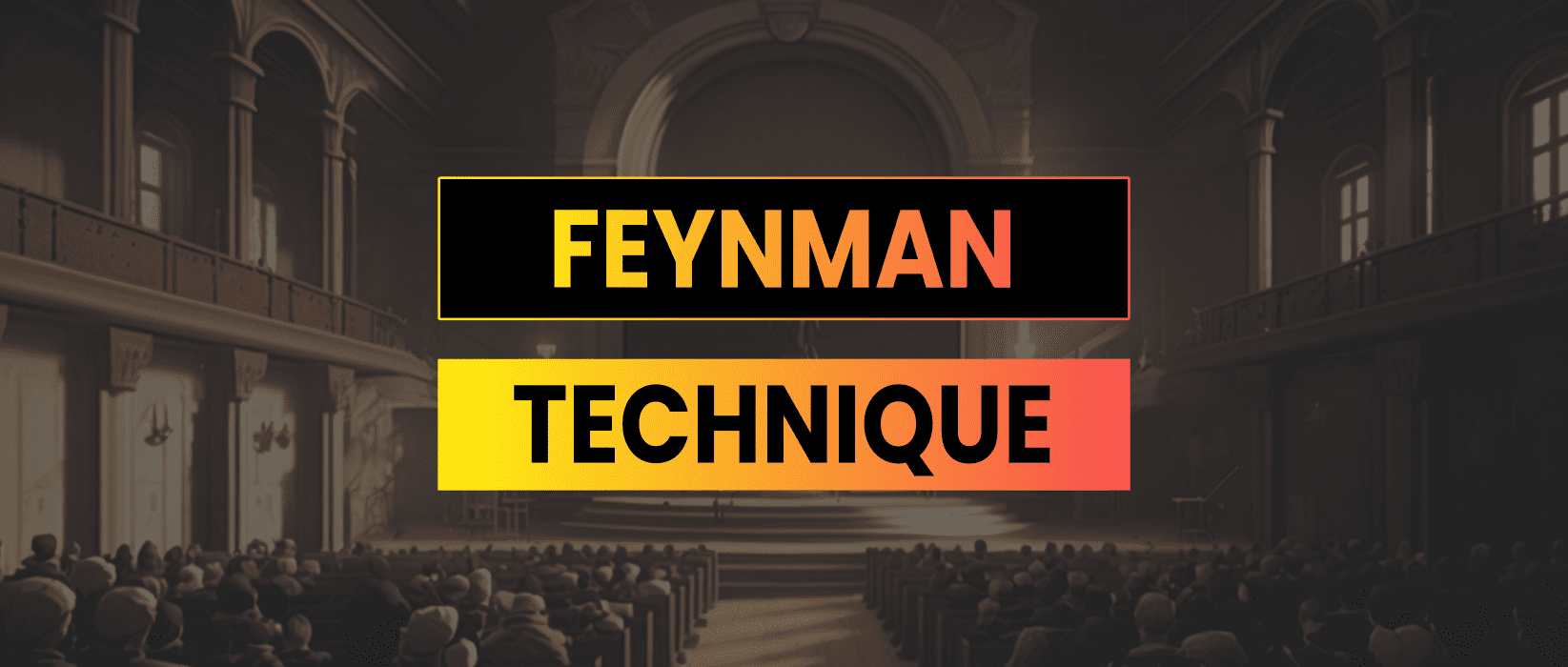The Feynman Technique is a learning tool developed by the infamous physicist Richard Feynman. It involves breaking down complex concepts into simple terms and explaining them as if you were teaching the subject.
In March 2020 Covid lockdowns were imposed and I started creating content based on what I was learning or interested about at the time. Over the last three years I’ve developed my own take on a modernised version of the Feynman technique incorporating research, blogging and video creation to better understand the topics that I’m interested in.
- The Feynman Technique
- Feynman 2.0 | A Modern Twist
- Choosing Subjects
- Research
- Write Up Notes
- Create Content
- Feedback Loops

The Feynman Technique
The Feynman Technique is based on the idea that the best way to understand a subject is to teach it to someone else.
Here is a summary of the original Feynman Technique:
- Choose a subject: Start by selecting a topic or concept that you want to understand better.
- Teach it to yourself: Pretend as if you are teaching the subject to someone who has no prior knowledge of it. Write down or speak out the explanations in your own words, without referring to any notes or textbooks.
- Identify areas of confusion: While explaining the subject, if you encounter areas where you are unsure or struggle to explain, take note of these areas. They represent the areas where you need to focus more attention and study.
- Simplify: Continue to simplify the explanation until you are able to explain the subject in layman’s terms, using everyday examples and analogies.
- Review and Refine: Once you have gone through the above steps, review your explanation and refine it further. Try to make it as concise as possible.
The Feynman Technique helps to reinforce understanding by actively teaching the subject, and constantly questioning where the grey areas in your understanding are. The process of simplifying the information down to the fundamentals reinforces the knowledge.
Feynman 2.0 | A Modern Twist
By combining the Feynman Technique with the power of digital technology and scale of the internet you can create an effective and engaging way to learn and share new information.

- Choose Subjects: For me this is often something related to blockchain development or financial technology. I have an app where I keep a running list of things I want to learn about.
- Research: I start by finding blog posts, YouTube videos, official documentation and generally searching the web for information on the subject matter. I try to reach out to experts in that field to get their opinions and ask questions that aren’t answered by the search engines.
- Write Up Notes: While researching I write up notes in a txt file which I then write up in to a blog post on a blog you are now familiar with.
- Create Content: Once the blog post is at some stage complete I start to think about making video content to summarise the content into a condensed 5-10 minute YouTube video.
- Feedback Loops: Once published I’ll get feedback in the comments which will tell me all the words I’m still mispronouncing.
Choosing Subjects
Choosing optimal subjects to learn about is the first and most crucial step. It is essential to select a topic that you have an interest in and are motivated to learn. This will make the learning process more enjoyable and increase the chances of retaining the information.
Keeping a running list of things you want to learn about in an app is a great way to keep track of your interests and ensure that you are making progress in your learning journey. I sometimes catch something on Twitter but don’t have time to look into it at the time so I just make a note of it and come back to explore it when I’m in the office.
This “Feynman Technique 2.0” topic has been in my personal list for over a year and it’s taken me some time to delve in to it. This is an example of a subject which is more exploratory and looking at productivity systems rather than pure research on an existing or emerging technology.
There is a constant battle about creating content around subjects you want to create content about and creating content that other people actually want to consume. Trending topics and latest developments tend to perform well for content creators while you may find writing about art history more enjoyable which is fine. Be aware and manage expectations accordingly.
Research
The aim of this step is to gain a thorough understanding of the subject matter so that you can effectively explain it in your own words. Knowing that you will later be creating content that may be seen by a large number of your peers is quite motivating to study hard and study smart.
Additionally, you also reach out to experts in the field to get their opinions and ask questions that aren’t answered by search engines. This is a valuable step as it provides you with an opportunity to gain insights and perspectives from individuals who have extensive knowledge and experience in the subject. By asking questions, you can also clarify any areas of confusion and gain a deeper understanding of the topic.

There are near infinite resources to research a subject online, and the best method depends on the subject.
- Search engines such as Google are great for quickly finding information and external resources to look into. There are also internal search functions on most sites, one of my favourite is GitHub’s search bar which let’s you search the worlds entire open source code repositories.
- Official documentation is often the definitive resource for a topic, especially for developers. These can provide in-depth information and are often written by the leading experts in the field.
- YouTube is a great resource for getting an overview of a subject. You can find breakdowns, book summaries and opinion pieces from people that have been down this road before you.
- Social media platforms often include a search function for hashtags which can be used to get the very latest breaking information in condensed form. Twitter, LinkedIn, and Reddit can be a great resource for finding information on a subject. You can follow experts in the field, join groups related to the subject, or participate in discussions to gain insights and perspectives.
- AI Language Models (ChatGPT) I think there’s a case where if not now then in the future we will be using AI tools to explain complex subject better than humans can. This is only useful for established subjects with a history of training data online.
- Outreach to colleagues you know or can connect with on social media to get opinions and thoughts from people working or specializing in that field. This often uncovers areas of new developments and further rabbit holes to explore.
Write Up Notes
While researching a topic I take notes in a text file in vsCode. I use markdown for formatting as I find it makes the document a little prettier while still being compatible with plain text systems.
My notes are generally a chaotic mess of:
- brain dumps
- bullet points
- quotes
- links
- subjects to explore further
Once I feel I have a fairly good understanding of the subject matter I break the content down into 5-10 headings which will form the subject of the blog post. I’ll then write out the blog post in my own words explaining each heading as if I was teaching it to a 3rd party.
Quite quickly this highlights areas where you don’t know what you are talking about. If writing about a subject is difficult it’s likely due to a lack of deep understanding.
At the end I’ll go through my notes and make sure that I’ve covered everything that I wanted to talk about and read through to do a final edit and refresh before I go on camera.
Create Content
The next step is to summarise the content into a short video. Talking in front of camera is nerve racking at first and even more so when you only learnt about the thing you are going to talk about earlier in the week.
You don’t need to be a expert in any field to create content. If you can clearly explain the subject in a way that is entertaining and enjoyable for an audience then you can add value.
I’m lucky working in Blockchain because there are no industry experts with 20 years experience. If you work in an emerging field you’ll find everyone is in the same position figuring things out as they go.
When you first start making video content it likely wont be great. I was awkward and uncomfortable in front of camera, spoke so fast no one could understand what I was saying and my video editing made me look like an oompa loompa. Some of those things I’m still working on 🤷♂️
Do it anyway and you’ll get better as you go. You can start with 15 second TikToks on your phone and see what resonates and gets views. While vanity metrics aren’t the most important thing it is rewarding to create content that gets watched and appreciated.
Some free tools that I use for editing are:
- DaVinci Resolve – steep learning curve but incredible software
- Capcut – mobile app for editing shorts
- OBS – for screen recording and streaming
Good audio is important so get an external microphone. Boya do one for under $20 which I used for a long time before upgrading to a Rode Wireless GO system which I love as I can just turn it on and forget I’m wearing it.
The camera I use is a Sony A6400 with a 16mm Sigma prime lens but in all honesty I could probably create my content just as well with a phone and webcam.
Lighting is more important if you want “The YouTube Look” and I use a Godox ULC150 key light with a Aperture light dome mini soft box and the for practicals I use little LED RGB tubes.
None of this is necessary to get started and more effort in brainstorming ideas for content and storylines will gain traction faster than the most expensive camera equipment.
There is a lot to learn with creating a decent video, you need to become a one man film studio with a basic understanding of editing, lighting, audio etc.
The key is to turn the lights on and talk to the camera/phone. You’ll soon get a feel for how well you know the subject and on take 24 it’s probably worth going back to the research step.

Feedback Loops
Richard Feynman lectured at US colleges while today we can get instant feedback within minutes of posting a video online.
90% of the feedback you get isn’t helpful but the 10% that is makes it worth sifting through the comments section. If you get overly negative feedback, treat it with compassion, you don’t know that persons situation or what they are going through and there’s nothing you can do to help. Just block them and get on with your day (on YouTube there’s an option to hide from channel which means that comment and any further comments wont be seen by you or anyone else but it lets them vent).
The useful feedback you get will be in the form of:
- Contrarian opinions: Everyone came to their own conclusions for a reason and understanding a counter-argument is a great way to challenge your own assumptions.
- Improvements: I get a lot of comments about talking to fast and it’s useful feedback to slow down. I might get it tattooed on my hand.
- Ideas for exploration: People like to point out things you’ve missed which is really useful to fill in knowledge gaps and also look for areas where you can dive into at a later date.
- Corrected on mistakes: I say a lot of words wrong, partly because I’m British and partly because I’m an idiot that reads to much and talks to people not enough. My classic is Meeeatamask or Meeeataverse which I mispronounced for maybe 3 years before Facebook changed their name to Meta at which point I got a lot of feedback. Being corrected on your mistakes online is very useful to look slightly less foolish in real life.
By combining the traditional Feynman Technique with modern tools such as blog posts and YouTube videos, individuals can not only gain a comprehensive understanding of a subject but also share their knowledge with others.
The key to making this technique work is to choose subjects that align with your interests and skills, conduct thorough research, and simplify the information into a clear and concise explanation.
Whether you are looking to improve your knowledge for personal or professional reasons, I’d recommend the Feynman Technique 2.0 as a valuable tool research and outreach.


